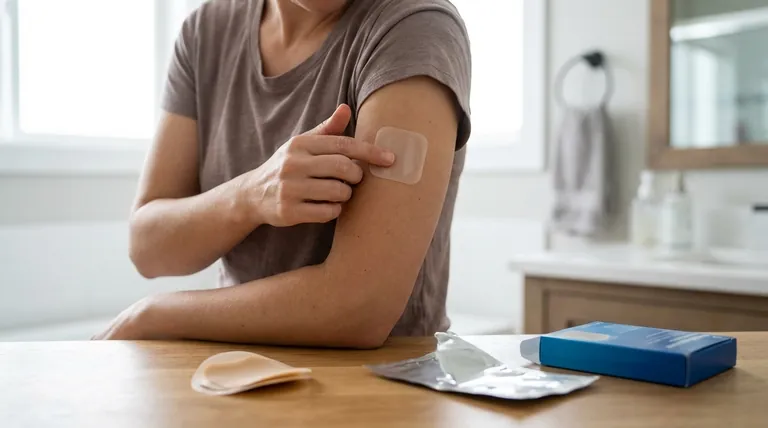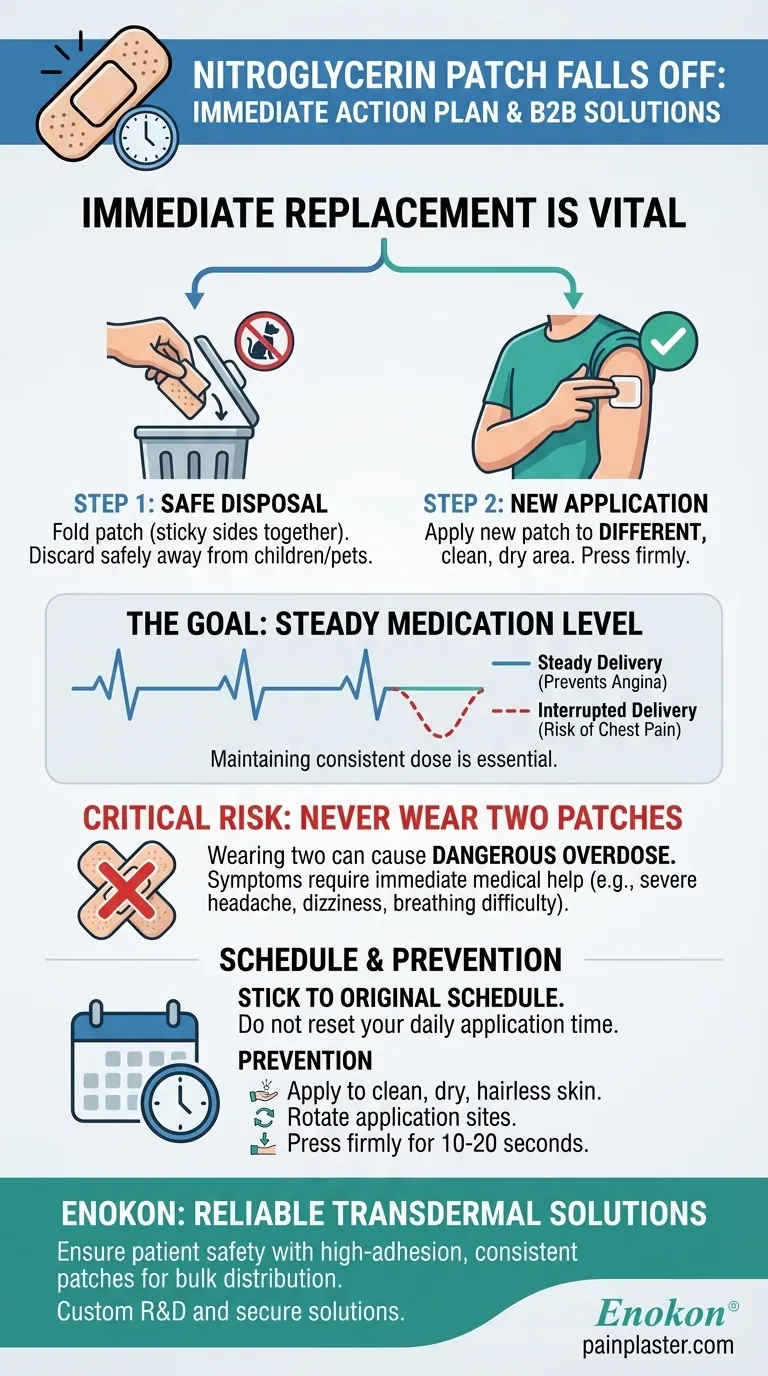If a nitroglycerin patch falls off, you should immediately replace it with a new one. Fold the old patch in half with the sticky sides together and dispose of it safely, ensuring it is out of the reach of children and pets. Apply the new patch to a different, clean, and dry area of skin to prevent irritation.
The primary goal of nitroglycerin patch therapy is to maintain a consistent level of medication in your system to prevent chest pain (angina). Replacing a lost patch promptly is essential for maintaining this protection without altering your overall daily schedule.

The Core Principle: Maintaining a Steady Dose
Nitroglycerin patches work by delivering medication slowly and continuously through your skin. This steady supply helps relax and widen blood vessels, making it easier for blood to flow to your heart and preventing angina attacks.
Why a Detached Patch is a Concern
When a patch becomes loose or falls off, the delivery of this critical medication is interrupted. This break in treatment can leave you unprotected, increasing your risk of experiencing chest pain. The immediate goal is to restore that steady delivery as quickly as possible.
The Correct Action Plan
If a patch falls off, first try to press it back onto the skin. If it does not stick firmly and completely, do not use tape or adhesives to hold it in place. Instead, you must discard it and apply a fresh one.
Place the new patch on a different, clean, dry, and hairless area of skin, such as the chest, upper back, or upper arm. Press down firmly for about 10-20 seconds, especially around the edges, to ensure it is secure.
How to Safely Dispose of a Used Patch
A used or dislodged patch still contains active medication that can be harmful to others. To dispose of it, carefully peel it off, fold it in half with the sticky, medicated sides touching, and discard it in a place inaccessible to children or pets.
Understanding the Key Risks
Managing your medication involves understanding both the risk of missing a dose and the risk of taking too much. The guidance for replacing a patch is designed to balance these factors safely.
The Danger of an Overdose
You should never wear two patches at the same time unless specifically instructed by your healthcare provider. Doing so can lead to an overdose.
Symptoms of a nitroglycerin overdose are serious and require immediate medical attention. They can include a severe or persistent headache, dizziness, fainting, confusion, blurred vision, nausea, vomiting, and difficulty breathing.
Sticking to Your Original Schedule
Applying a new patch mid-day does not reset your schedule. If you normally remove your old patch and apply a new one at 9 a.m., you should continue to do so, even if you had to replace one the previous afternoon. This consistency prevents confusion and accidental overdose.
Preventing Patches from Falling Off
To ensure good adhesion, always apply your patch to a clean, dry, and relatively hair-free area of skin. Rotate application sites with each new patch to prevent skin irritation, which can affect how well the patch sticks. The patches are designed to be worn during normal activities, including showering, bathing, and swimming.
Making the Right Choice for Your Health
Your consistent action is key to managing your condition effectively. Always follow the specific instructions provided by your doctor or pharmacist.
- If your patch falls off: Replace it with a new one on a different patch of skin and maintain your regular daily application and removal schedule.
- If you are ever unsure about your dose: Do not apply a second patch. Call your doctor or pharmacist for immediate clarification.
- If you experience severe dizziness, fainting, or difficulty breathing: Remove the patch at once and seek emergency medical help.
Proactively managing your treatment is the surest path to controlling your symptoms and protecting your health.
Summary Table:
| Action | Key Instruction | Rationale |
|---|---|---|
| If Patch Falls Off | Replace immediately with a new patch on a different, clean, dry skin area. | To restore continuous medication delivery and prevent angina. |
| Disposal | Fold old patch in half (sticky sides together) and discard safely out of reach of children/pets. | Used patches contain active medication that can be harmful. |
| Schedule | Maintain your original daily application/removal time. Do not reset the schedule. | Prevents confusion and accidental overdose. |
| What to Avoid | Never use tape to reattach a patch. Never wear two patches at once unless directed. | Tape can alter drug delivery. Two patches can cause a dangerous overdose. |
Ensure your patients have access to reliable, high-adhesion transdermal patches. As a bulk manufacturer of nitroglycerin and other pain relief patches, Enokon provides healthcare and pharmaceutical distributors with technically advanced, consistent, and secure transdermal solutions. Benefit from our custom R&D expertise to develop patches that stay on and deliver medication as intended. Contact our experts today to discuss your requirements for reliable transdermal drug delivery systems.
Visual Guide

Related Products
- Far Infrared Deep Heat Relief Patches Medicated Pain Relief Patches
- Capsaicin Chili Medicated Pain Relief Patches
- Asthma Cough and Pain Relief Patch for Adults and Kids
- Heating Pain Relief Patches for Menstrual Cramps
- Icy Hot Menthol Medicine Pain Relief Patch
People Also Ask
- How do pain relief patches work? A Guide to Targeted, Long-Lasting Pain Relief
- How quickly does the Deep Heat Pain Relief Back Patch activate and how long does it provide warmth? Get 16-Hour Relief
- How do Deep Heat Pain Relief Patches provide pain relief? Discover the Drug-Free Mechanism
- How do pain relief patches provide targeted relief? Discover the Science Behind Effective Pain Management
- What are pain relief patches and how are they used? A Guide to Safe, Targeted Relief















